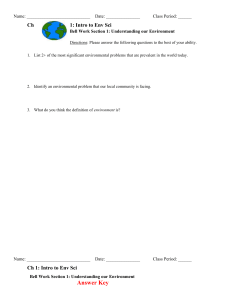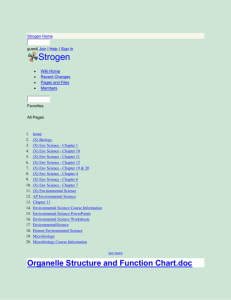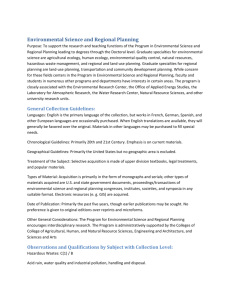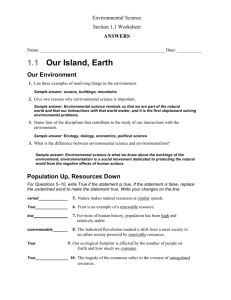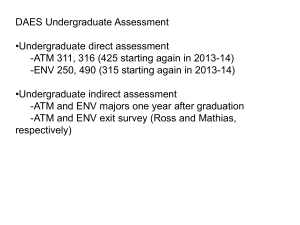Chapter 1: History of Environmental Science
advertisement
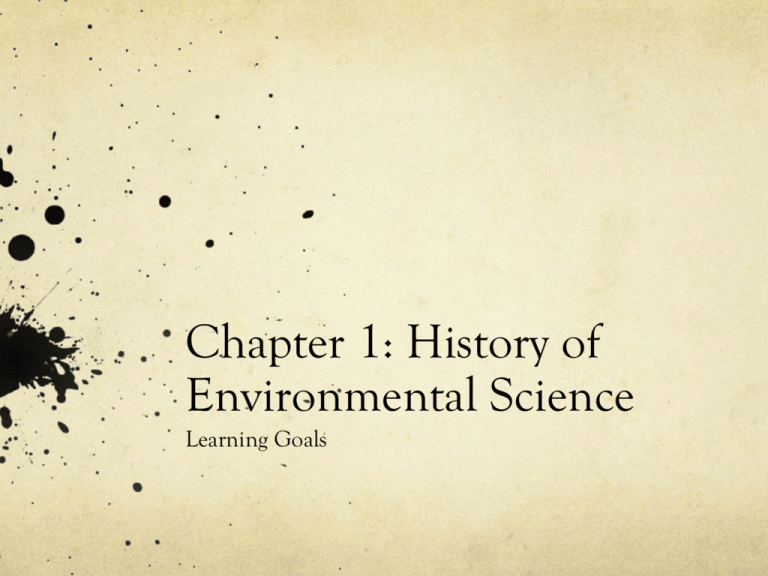
Chapter 1: History of Environmental Science Learning Goals Key vocabulary Sustainability Pollution Biodiversity Nondegradable Biodegradable Resource depletion Renewable resource Closed system Nonrenewable resource extinction Define Environmental Science and compare/contrast environmental science to Ecology List and briefly describe the five major fields of study that contribute to environmental science Describe environmental effects of huntergatherers, agricultural revolution, and industrial revolution Distinguish the difference between renewable and non-renewable resources and give examples Describe the 3 major categories of environmental problems Describe what the “Tragedy of the Commons” is and what it means Explain the law of supply and demand What are the differences between a developed and a developing country? Give examples of each Explain what sustainability is and describe why this is the goal of environmental science Define Environmental Science and compare/contrast environmental science to Ecology Collection of different sciences Goal is to understand relationship between humans & the world/environment Focuses on 3 main areas: Conservation + protection of natural sciences Environmental education Environmental research Difference between Env. Sci. & Ecology Ecology- how living things interact with each other and the nonliving environment Ecology is the foundation for Env. Sci. 5 fields of Study included in Env. Sci. Biology-study of living things Earth science-study of Earths nonliving systems & planet Physics- study of matter & energy Chemistry- study of chemicals & their interactions Social science- study of human populations Environmental Effects from… Hunter-gatherers- collected plants and hunted/scavenged animals changed environment to hunt prey , spread plants Agricultural revolution—growing, breeding, & caring for plants & animals as food & resources increased the number of people increased, changed the food we eat (selective breeding) and destroyed habitats for farming Industrial Revolution-shift from using energy (E) from animals & running H2O to using fossil fuelsIncreased agriculture industry & transportation, therefore prices dropped, increased food production & populations These things lead to environmental problems: pollution, habitat loss, etc. Resources Renewable Nonrenewable Resource that can be replaced by natural processes somewhat quickly Resources that form at a slower rate than the rate it’s consumed or used examples? Depleted-when a resource is mostly used up examples? 3 Categories of env. problems resource depletion- when large amounts of a resource are used up pollution- an undesirable change in air,water, or soil that has a negative impact on living things, examples? loss of biodiversity- a decrease in the variety of species where extinction could lead to economic, ecological, scientific, aesthetic, and recreational hardship 2 main causes of env. problems: population growth is too rapid for environment to maintain & people are using up, wasting, or polluting natural resources faster than they can be replenished "Tragedy of the Commons"pg.16 an essay written by Garrett Hardin describes the attitude of how people use resources states that environmental problems is due to conflict between short term interest and long term welfare of society take away:people need to take responsibility for maintaining resources Law of Supply & Demand economics- a science concerned with the process or system by which goods and services are produced, sold, and bought law of supply and demand- the greater the demand for a limited supply of something, the more it is worth application- gasoline, oil Developed Country higher incomes slower population growth diverse industrial economics strong social support examples: U.S., Canada, Japan, Western Europe Developing Country lower incomes simple & agricultural based economies rapid population growth examples:Mexico, Brazil, Malaysia Ecological Footprint shows the productive area of Earth needed to support one person in a particular country see pg. 19 Sustainabilty Where the needs of a population are met so that the population can survive indefinitely developed countries are using resources faster than they can be replaced goal=find solutions so all people can live healthy good lives!
